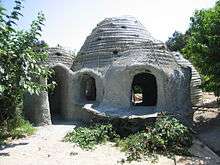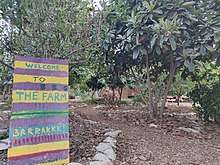Pomona College Organic Farm
The Pomona College Organic Farm is an organic farm located on 1.2 acres (0.49 ha)[1] of the southeast corner of Pomona College's campus[2][3] within Blanchard Park (more commonly known as "the Wash"). It was begun as an experimental permaculture project by a group of three friends in spring 1998,[4] and was institutionalized in 2006.[5]

History
The farm was begun in the spring of 1998, when students began composting dining hall waste and planted crops in an unused portion of campus.[6][4] Masanobu Fukuoka's book The One Straw Revolution provided the initial inspiration. One student remained on campus to tend to the farm over the summer, but according to the farm's website, only a single tomato grew.[4] Over the next few years, students from the "Gorilla Farming Club" worked to improve the nitrogen content of the soil and remove rocks.[4]
During this time, the farm developed a reputation as an activist space,[4] with extensive marijuana smoking, squatting, and other exploits. This, combined with the farm's unofficial status, led to strained relations with the college's administration.[7] In summer 2002, students constructed an earth dome using Nader Khalili's superadobe designs, but the college demolished it at the start of the fall 2002 semester because of safety and permitting concerns.[4] In April 2003, plans began for a new, institutionally-approved Earth Dome,[4] which was completed in 2005. In May 2006, the farm and the college reached an agreement on rules for the farm, and it has since become institutionalized[5][8] and expanded to include the East Farm.[4]
Layout

The farm occupies 1.2 acres (0.49 ha)[1] of the far southeastern corner of Pomona College's campus, within the naturalistic portion of the campus known as "the Wash" (formally Blanchard Park[9]). It is split into two halves, separated by the college's hammer throw field.[10] The West Farm includes the superadobe Earth Dome, as well as a number of fruit trees, rock-lined student plots, an outdoor classroom, and a chicken coop.[6] The East Farm has a 162-square-foot greenhouse and is used to grow crops and compost waste.[6][11] A number of coast live oak trees dot the area.
Operations
The farm grows some of the food used in Pomona's dining halls, composts dining hall waste,[12] operates a food stand,[5] and facilitates a course on agriculture in the college's Environmental Analysis program.[13]
It also hosts a number of events, including an annual "FarmFest",[14] and provides a space for quiet retreat.[12]
It is funded by proceeds from produce sales, the Associated Students of Pomona College, and the Environmental Analysis Department. Pomona alumnus Ronald Lee Fleming has also donated to the farm, funding a statue.[15]
Further reading
- Long, Adam J. (1 April 2013). "A Guide to the Pomona College Organic Farm: An Introduction to the Farm's History and Basic Gardening Skills and Techniques". Pomona Senior Theses.
References
- "Pomona College Organic Farm". Pomona College. 26 August 2019. Retrieved 8 August 2020.
- "Description of The Farm at pomona.edu". Archived from the original on July 3, 2014.
- Marcus McVane, Put This in Your Soil Archived May 12, 2014, at the Wayback Machine, Pomona College, April 22, 2014.
- "Farm Resources". Pomona College. 26 August 2019. Retrieved 8 August 2020.
- Freedman, Kara (23 September 2011). "Pomona College Farm Stand Brings Fresh Produce to Campus". The Student Life. Retrieved 5 August 2020.
- Wax, Shelby (4 November 2013). "The Roots of Pomona College's Organic Farm". The Student Life. Retrieved 5 August 2020.
- Enzminger, Peter. "Down on the Farm". Pomona College Magazine (Fall 2006). Pomona College. Archived from the original on 12 May 2008. Retrieved 5 August 2020.
- "2006". Pomona College Timeline. Pomona College. 7 November 2014. Retrieved 5 August 2020.
- "Campus Facilities". Pomona College Catalog. Pomona College. Retrieved 2 August 2020.
- Orenstein, Natalie (21 April 2011). "Petition to Relocate Hammer Throw Field Draws Criticism". The Student Life. Retrieved 5 August 2020.
- Hernandez, Cindy. "Fine Feathered Friends" (PDF). Pomona College Magazine (Winter 2009). Pomona College. Retrieved 7 August 2020.
- Schmidt, Jennifer (11 November 2013). "Tending More Than Just a Seed". The Student Life. Retrieved 5 August 2020.
- Asokin, Ratik (November 14, 2011). "8 Classes You Might Have Overlooked". The CMC Forum. Retrieved 5 August 2020.
- Xu, Sitong (29 April 2016). "FarmFest Celebrates Earth Day". The Student Life. Retrieved 5 August 2020.
- "2008". Pomona College Timeline. Pomona College. 7 November 2014. Retrieved 5 August 2020.